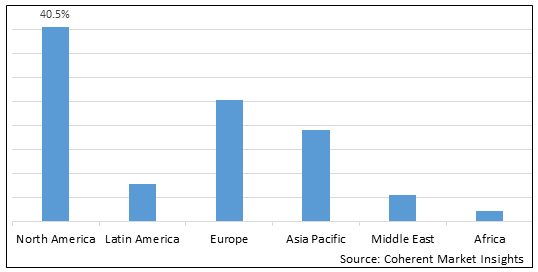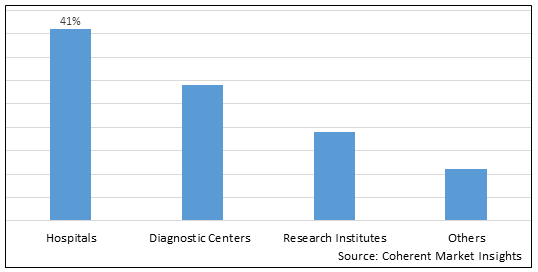Frasier Syndrome Market is estimated to be valued at USD 155.8 Mn in 2025 and is expected to reach USD 220.7 Mn in 2032, exhibiting a compound annual growth rate (CAGR) of 5.1% from 2025 to 2032. Frasier syndrome is a rare genetic disorder characterized by male-to-female sex reversal along with developmental defects of the kidneys and reproductive organs. It is caused by mutations in the WT1 gene. Frasier syndrome diagnosis involves genetic testing and biochemical testing to analyze the level of protein in the body. The increasing prevalence of the disease and growing awareness are the key factors driving market growth.
The Frasier syndrome market is segmented by test type, end user, and region. By test type, the market is segmented into genetic testing, biochemical testing, and others. The genetic testing segment accounted for the largest share of the market in 2022. The large share of this segment can be attributed to the accuracy and specificity of genetic tests. Genetic testing helps in the early diagnosis of the disease.
Frasier Syndrome Market Regional Insights:
- North America is expected to be the largest market for Frasier syndrome market during the forecast period, accounting for over 40.5% of the market share in 2025. The growth of the market in North America is attributed to the high awareness, favorable reimbursement policies, and developed healthcare infrastructure in the region.
- The Europe market is expected to be the second-largest market for Frasier syndrome market, accounting for over 25.2% of the market share in 2025. The growth of the market in Europe is attributed to rising research funding and increasing cases in the region.
- The Asia Pacific market is expected to be the fastest-growing market for Frasier syndrome market, with a CAGR of over 18.9% during the forecast period. The growth of the market in Asia Pacific is attributed to improving healthcare infrastructure, rising disposable incomes, and growing awareness in the region.
Figure 1. Global Frasier Syndrome Market Share (%), by Region, 2025

To learn more about this report, Download Free Sample
Analyst viewpoint on Frasier Syndrome Market:
The Frasier Syndrome Market is anticipated to develop at a steady growth rate over the forecasted period. Currently, ultrasound testing is considered the gold standard for diagnosis of the disorder in prenatal conditions. Additionally, there are very few companies that offer genetic testing methods for Frasier syndrome. As this is a very rare disorder, there are very few cases diagnosed each year thus, the market is anticipated to develop at steady growth rate.
Frasier Syndrome Market Drivers:
- Increasing prevalence of Frasier syndrome: The rising prevalence of Frasier syndrome globally is a major factor driving growth of the frasier syndrome testing market. Frasier syndrome is a rare genetic disorder with an estimated prevalence of 1 in 1 million births. However, the prevalence has been rising steadily over the years due to greater awareness and improved diagnosis. The exact cause of Frasier syndrome is still unknown, but genetic mutations in the WT1 gene are responsible in the majority of cases. The increasing patient pool is creating demand for effective diagnostic testing. This is fueling the uptake of genetic and biochemical tests for confirmation of Frasier syndrome.
- Advancements in genetic testing techniques: The frasier syndrome testing market is aided by continuous advances in genetic diagnostics that allow for faster, more accurate, and more convenient testing options. Next-generation sequencing techniques like whole exome sequencing have emerged as preferred methods owing to their ability to test multiple genes simultaneously. Other advances like biochips, nanotechnology, and automation have improved the throughput and efficiency of tests. Companies are developing innovative genetic panels using cutting-edge technologies for the diagnosis of Frasier syndrome. Such technological advances are supporting market growth.
- Growth in personalized medicine: The emergence of personalized medicine is boosting the need for genetic testing in Frasier syndrome. Genetic testing identifies mutations specific to an individual patient, enabling personalized treatment approaches tailored to the patient's genetic profile. For instance, chemotherapies can be selected based on individual tumor genetics. Frasier syndrome testing allows risk assessment for developing certain cancers, like Wilms tumor and gonadoblastoma. This facilitates earlier interventions and personalized screening plans. The expansion of precision medicine practices is contributing significantly to market growth.
Frasier Syndrome Market Opportunities:
- Increasing awareness programs: Patient advocacy organizations are conducting extensive activities to improve Frasier syndrome awareness among patients, families, and healthcare professionals. These initiatives provide information on symptoms, testing options, and available support resources. For instance, the MAGIC Foundation launched an awareness campaign offering downloadable materials and promoting Frasier syndrome facts. Such efforts are creating lucrative opportunities by educating people regarding the condition, eventually driving testing demand.
- Launch of point of care tests: Companies are working on developing rapid point-of-care diagnostic tests for Frasier syndrome detection. These tests analyze specimens like blood or saliva at the site of patient care, eliminating delays associated with send-out laboratory testing. Quick and easy sample collection and processing, coupled with faster turnaround times, improve patient convenience. Approval and launch of user-friendly POC assays will help decentralize testing and increase adoption rates.
Frasier Syndrome Market Report Coverage
| Report Coverage | Details | ||
|---|---|---|---|
| Base Year: | 2024 | Market Size in 2025: | USD 155.8 Mn |
| Historical Data for: | 2020 To 2024 | Forecast Period: | 2025 To 2032 |
| Forecast Period 2025 to 2032 CAGR: | 5.1% | 2032 Value Projection: | USD 220.7 Mn |
| Geographies covered: |
|
||
| Segments covered: |
|
||
| Companies covered: |
Thermo Fisher Scientific, Invitae Corporation, GE Healthcare, Koninklijke Philips N.V., Mindray Medical, Siemens, Canon Medical Systems Corporation, FUJIFILM Sonosite Inc., ESAOTE SPA, SAMSUNGHEALTHCARE, Empire Genomics Inc., BPL Medical Technologies, Trivitron Healthcare, and Hitachi Healthcare |
||
| Growth Drivers: |
|
||
| Restraints & Challenges: |
|
||
Uncover macros and micros vetted on 75+ parameters: Get instant access to report
Frasier Syndrome Market Trends:
- Partnerships and collaborations: Strategic partnerships between biopharma companies, research institutions, and testing laboratories are rising. Such collaborations allow access to proprietary techniques, databases, and research expertise, accelerating test development and commercialization.
- Data integration and analysis: Leveraging big data capabilities to integrate genetic, clinical, and demographic data is an important trend. Big data analytics help uncover patterns and insights from diverse datasets, informing Frasier syndrome testing development and strategies. For instance, Qiagen’s Ingenuity Variant Analysis application enables optimized interpretation of NGS data for genomic biomarker analysis. The use of AI, machine learning, and cloud-based informatics will enhance data utilization.
Frasier Syndrome Market Restraints:
- Reimbursement challenges: Reimbursement issues for genetic testing are a major barrier hampering Frasier syndrome test adoption. Tests may be deemed experimental or unnecessary by payers, and thus denying coverage. Low reimbursement rates and differences in coverage policies across regions limit affordability. Patients may avoid testing due to high out-of-pocket costs. Lobbying for positive coverage decisions and the implementation of value-based payment models will be imperative to address this restraint.
- Prenatal testing limitations: Despite the high utility of prenatal genetic diagnosis, testing for Frasier syndrome remains challenging. This is because WT1 gene mutations have low penetrance and variable expressivity. There is insufficient evidence correlating genotype and phenotype to support a definitive prenatal diagnosis. Cell-free fetal DNA testing has not yet demonstrated adequate accuracy. These limitations hinder prenatal testing adoption, restricting market expansion. An enhancement of predictive capabilities can help overcome this restraint.
Recent Developments in Frasier Syndrome Market
- In July 2022, GE Healthcare, a medical device company, announced its most advanced ultrasound yet, the next-generation Voluson Expert 22. This latest addition to GE Healthcare's award-winning Women's Health portfolio employs graphic-based beam former technology, which generates higher-quality images and provides greater flexibility in imaging activities. Artificial Intelligence (AI)-powered cutting-edge solutions ensure more consistency in assessments and a reduced number of tasks
- In September 2022, Royal Philips, a global leader in health technology, announced the upcoming addition of the FetView cloud-based fetal ultrasound image sharing and reporting software for obstetrics/gynecology (OB/GYN). FetView, a vendor-neutral cloud-based ultrasound imaging platform, will employ ultrasound image data to express fetal development projections and provide a user-friendly platform for physician to physician and physician to patient communication.
Figure 2. Global Frasier Syndrome Market Share (%), by End User, 2025

To learn more about this report, Download Free Sample
Top companies in Frasier Syndrome Market:
- Thermo Fisher Scientific
- Invitae Corporation
- GE Healthcare
- Koninklijke Philips N.V.
- Mindray Medical
- Siemens
- Canon Medical Systems Corporation
- FUJIFILM Sonosite Inc.
- ESAOTE SPA
- SAMSUNGHEALTHCARE
- Empire Genomics Inc.
- BPL Medical Technologies
- Trivitron Healthcare
- Hitachi Healthcare
Definition: Frasier syndrome is a rare genetic disorder characterized by male to female sex reversal and gonadal dysgenesis along with renal and reproductive anomalies. It results from mutations in the WT1 gene and is inherited in an autosomal dominant pattern. Diagnosis is done by genetic testing to identify pathogenic variants in the WT1 gene and biochemical assays to detect protein levels. Frasier syndrome testing aims to confirm the diagnosis, enable genetic counseling, guide treatment decisions, and allow prenatal diagnosis. The market comprises sales of genetic and biochemical diagnostic tests used in Frasier syndrome detection globally.
Share
Share
About Author
Ghanshyam Shrivastava - With over 20 years of experience in the management consulting and research, Ghanshyam Shrivastava serves as a Principal Consultant, bringing extensive expertise in biologics and biosimilars. His primary expertise lies in areas such as market entry and expansion strategy, competitive intelligence, and strategic transformation across diversified portfolio of various drugs used for different therapeutic category and APIs. He excels at identifying key challenges faced by clients and providing robust solutions to enhance their strategic decision-making capabilities. His comprehensive understanding of the market ensures valuable contributions to research reports and business decisions.
Ghanshyam is a sought-after speaker at industry conferences and contributes to various publications on pharma industry.
Missing comfort of reading report in your local language? Find your preferred language :
Transform your Strategy with Exclusive Trending Reports :
Frequently Asked Questions
Select a License Type
EXISTING CLIENTELE
Joining thousands of companies around the world committed to making the Excellent Business Solutions.
View All Our Clients




